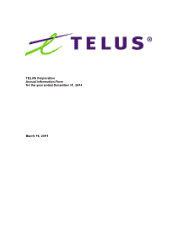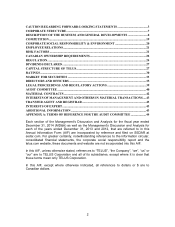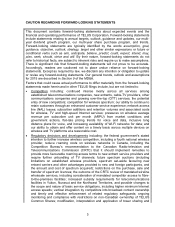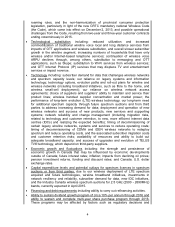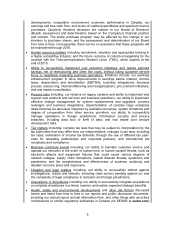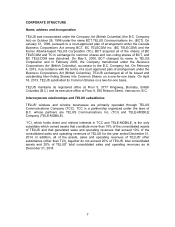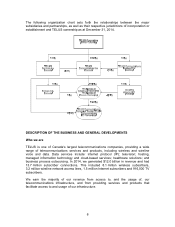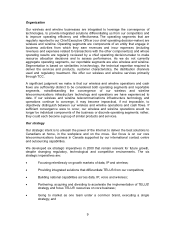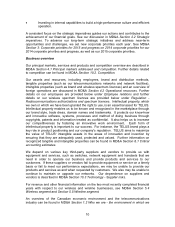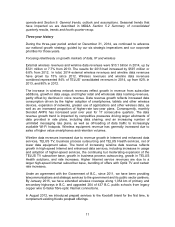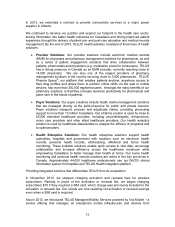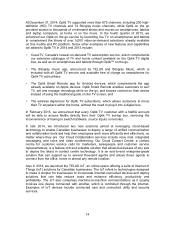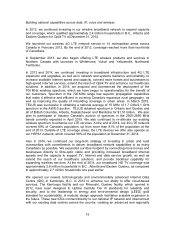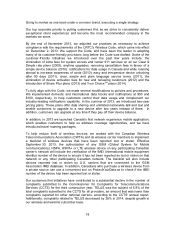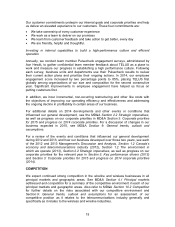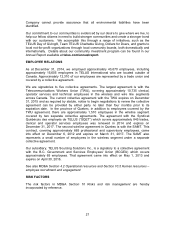Telus 2014 Annual Report Download - page 11
Download and view the complete annual report
Please find page 11 of the 2014 Telus annual report below. You can navigate through the pages in the report by either clicking on the pages listed below, or by using the keyword search tool below to find specific information within the annual report. 11
operate and Section 9: General trends, outlook and assumptions. Seasonal trends that
have impacted us are described in MD&A Section 5.2 Summary of consolidated
quarterly results, trends and fourth quarter recap.
Three-year history
During the three-year period ended on December 31, 2014, we continued to advance
our national growth strategy, guided by our six strategic imperatives and our corporate
priorities for those years.
Focusing relentlessly on growth markets of data, IP and wireless
External wireless revenues and wireline data revenues were $10.1 billion in 2014, up by
$721 million or 7.7% from 2013. The results for 2013 had increased by $597 million or
6.8% from 2012. In total, 2014 external wireless revenues and wireline data revenues
have grown by 15% since 2012. Wireless revenues and wireline data revenues
combined represented 84% of TELUS’ consolidated revenues in 2014, up from 82% in
2013, and 80% in 2012.
The increase in wireless network revenues reflect growth in revenue from subscriber
additions, growth in data usage, and higher retail and wholesale data roaming revenues,
partly offset by declines in voice revenue. Data revenue growth reflects increased data
consumption driven by the higher adoption of smartphones, tablets and other wireless
devices, expansion of networks, greater use of applications and other wireless data, as
well as an increased proportion of higher-rate two-year plans. Consequently, monthly
blended ARPU has increased year over year for 17 consecutive quarters. The data
revenue growth trend is impacted by competitive pressures driving larger allotments of
data provided in rate plans, including data sharing, and an increasing number of
unlimited messaging rate plans, as well as off-loading of data traffic to increasingly
available Wi-Fi hotspots. Wireless equipment revenue has generally increased due to
sales of higher value smartphones and retention volumes.
Wireline data revenues increased due to revenue growth in Internet and enhanced data
services, TELUS TV, business process outsourcing and TELUS Health services, net of
lower data equipment sales. The trend of increasing wireline data revenue reflects
growth in high-speed Internet and enhanced data services, including increases in usage
and adoption of higher-speed services, the continuing but moderating expansion of the
TELUS TV subscriber base, growth in business process outsourcing, growth in TELUS
Health solutions, and rate increases. Higher Internet service revenues are due to a
larger high-speed Internet subscriber base, bundling of offers with Optik TV and certain
rate increases.
Under an agreement with the Government of B.C., since 2011, we have been providing
telecommunications and strategic services to the government and its public sector partners.
By January 2015, we have extended wireless coverage along 1,054 km of primary and
secondary highways in B.C. and upgraded 264 of 437 B.C. public schools from legacy
copper wire to faster fibre-optic Internet connections.
In August 2012, we introduced prepaid services to the Koodo® brand for the first time, to
complement existing Koodo postpaid offerings.

